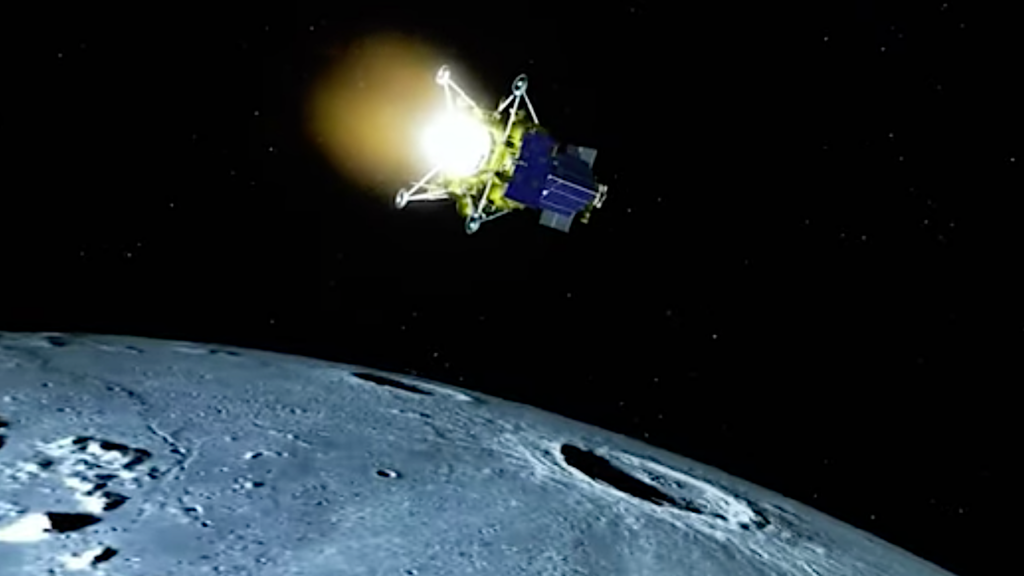Another Russian Rocket Malfunction?

Did the New Russia-Europe Mars Mission Narrowly Escape a Launch Disaster?, Popular Mechanics
“After the launch reached the initial parking orbit around the Earth, the Proton’s fourth stage (known as Briz-M, Russian for “breeze”) acted as a space tug, boosting the space probe on a path to Mars with four engine firings. What happened next was a close call that could have ended the mission catastrophically. And ExoMars still isn’t out of the woods … What is especially worrying about the latest accident is that Briz-M apparently exploded after just 10.5 hours in space, when its ExoMars cargo was still in the vicinity. The good news is that ExoMars appears to be undamaged by whatever happened to its space tug, but the mission is not out of the woods yet.”









As I recall, NASA backed out of that mission because of cuts in Planetary Science…brought about by SLS funding having strip-mined NASA’s budget.
So, rather than use a reliable rocket like a Delta Heavy or something, ESA had to use one with a history of frequent problems because we were too busy building an overly-expensive launch system to be bothered with something as trivial as a robotic mission to Mars.
It looks like SLS very nearly cost the world an expensive and crucial Mars mission and almost pushed that research down the calendar to the next Mars launch window.
How soon we forget the facts, the President who claimed he is NASA’s biggest fan is why NASA was not part of the ExoMars Missions:
Obama reduced NASA’s planetary science budget from $1.5 billion to $1.2 billion in 2013. The bulk of those cuts were from slashing the Mars exploration program from $587 million in 2012 to $360 million in the next fiscal year.
“There’s no easy way to say this: these cuts are devastating. The President’s request for just Mars exploration is $361 million, a crippling $226M drop in funding over the FY12 estimate, a 38.5% cut.
Read that again: a 38.5% cut. This will effectively halt the new exploration of Mars. It means pulling out of planning the ExoMars mission with the European Space Agency.”
http://io9.gizmodo.com/5885…
Small beer compared to what the Republican controlled Congress is wasting on SLS. If you’re going to hate on something at least do it in a possibly useful direction.
You need to check the numerous NASA budgets out that this President has submitted over the years. Too bad those darn facts get in the way of your false narrative. It has been the Republican lead Congress that has come to NASA’s aid by injecting larger budgets than what Obama proposed. Here is a recent sampling, you can have your warm stale beer now.
The Republican lead Congress increased the NASA 2016 budget some $750 million above the Obama Administration’s proposed NASA budget allocation of $18.5 Billion for Fiscal Year 2016, and an increase of more than $1.2 Billion over the enacted budget for FY 2015.
This 2017 budget request amounts to almost $300 million less than the recently enacted NASA budget for 2016 and specifically stipulates deep funding cuts for deep space exploration programs involving both humans and robots, during President Obama’s final year in office.
http://www.universetoday.co…
FY 2012 Provides $18.7 billion, the same amount the agency received in 2010.
FY 2013 The proposed 2013 federal budget unveiled by President Barack Obama keeps NASA funding relatively flat next year, but bites deep into the agency’s robotic Mars mission coffers while shifting new funds to human exploration and space technology.
FY 2015 request is for $17.460 billion, a reduction of $186 million dollars, or about a 1 percent cut. NASA’s topline budget for fiscal year 2015 is $18.01 billion — $549 million more than the White House requested for the space agency this year and about $350 million above NASA’s actual budget passed by Congress for 2014.
In the end its Congress that decides, and its problems when it comes to space exploration funding are bi-partison. “What’s in it for my voting district?” is the one priority that both parties consistently agree on.
Wasn’t it the James Webb Space Telescope that ate ExoMars’ funding?
I had not heard that. JWST isn’t a Planetary Science program. I don’t recall its critics even mentioning it. I suppose there is a way to point to anything that way though. What I read is that since SLS is for Mars they stripped away some of the Mars exploration budget to help pay for it. I complained about that at the time because we still need robotic scouting missions if we now plan to send people.
JWST isn’t a Planetary Science program, but neither is SLS.
Exploration Systems’ budget (which includes SLS) went down from $3 billion to $2.7 billion for FY12 to FY13. Planetary Science’s budget went down from $1.5 billion to $1.1 billion (ExoMars was canceled.)
JWST’s went up from $518 million to $627 million.
Commercial Crew went up from $406 million to $809 million.
If we have to point fingers…
It was hard get the point where “our” money went, but it killed the nice MSL size rover. I doubt that it is cheaper to built Mars2020 without ESA participation but this is 100% NASA.
This Exomars is without significant US participation, but the Rover contains a real superb mass spectrometer from Goddard. They are key part of the most important instrument, so US is still on board!!
That’s good to still be partners in the mission.
Hopefully that debris field will stay in solar orbit and not get dragged into Martian orbit or preferably it will crash but with a full burn-up on the way in. I guess that probably means falling straight in at Mars transfer velocity.
how about we start treating commercial crew programs as real businesses instead of government leaches?
“Hey will pay you to develop a rocket and then we will pay you again to use it and on top of that we will let you use all of our infrastructure to launch it for free!!!”
Because all of those line items, all added up, still come to as much as a full decimal place less money than the traditional, military-style contracting approach like what they are using to build SLS. Plus, those providers can shop for other customers besides just NASA so that when it’s all over with and Congress cuts off funding, or the ISS is deorbited, or whatever, they still fly.
National Aeronautics and Space Act:
Sec. 20102(c): “Commercial Use of Space.-Congress declares that the general welfare of the United States requires that the Administration seek and encourage, to the maximum extent possible, the fullest commercial use of space.
Sec. 20102(d): “Objectives of Aeronautical and Space Activities:
(5) The preservation of the role of the United States as a leader in aeronautical and space science and technology and in the application thereof to the conduct of peaceful activities within and outside the atmosphere.”
Sec. 20112(a): “The Administration, in order to carry out the purpose of this chapter, shall-
(4) seek and encourage, to the maximum extent possible, the fullest commercial use of space; and
(5) encourage and provide for Federal Government use of commercially provided space services and hardware, consistent with the requirements of the Federal Government.”
Anatoly is a good writer and he’s dug up story we might not otherwise have heard of. It is disturbing how problems with the Russian program are becoming more frequent. And of course there’s the issue of additional orbital debris.
Wasn’t the upper stage on an escape trajectory?
Yes, on a parallel course to an expensive payload. With luck, ExoMars will have a few course corrections and move out of the same trajectory.
It sounded to me like that debris is on its way to Mars or the Mars vicinity along with ExoMars.
Sadly as Russia cuts its space budget due to its financial troubles this is more likely to happen in the future. Here’s hoping that commercial crew stays on schedule so it is ready to take on the burden of the ISS if something happens with the Soyuz.
I’m sure the cuts don’t help, but this Briz-M thingy has been a bit of a dog’s breakfast for quite a few years. It has a long record of misadventures dating back to well before last year’s energy price collapse. The Wikipedia entry on it describes at least five mission failures or partial failures directly attributable to Briz-M since 2008. This recent explosion would be number six even though it does not seem to have caused a loss of mission.
A lot of Briz-M’s problems are probably due to its use of a turbo-pump-based propellant system even though the thrust of its engine is quite small – less than many Western engines that use a simple pressure-fed design. The turbopump-fed Briz-M engine (model 14D30) produces 4,400 lbs. of thrust vs., for example, 6,900 lbs. for SpaceX’s pressure-fed Kestrel engine which was used on the 2nd stage of their now-discontinued Falcon 1 vehicle. Despite having nearly the same specific impulse, the Russian engine weighs nearly twice as much and yields less than a third the thrust-to-weight ratio. The Kestrel, being a LOX/RP-1 engine, presumably also includes an igniter system in its mass budget. The Briz-M’s engine, running on storable hypergolics, needs none.
Russian space engineering enjoys a reputation of being simple, rugged and unsubtle. That reputation is, in my view, very questionable. Their system engineering choices often seem to result in pointless complexity and the introduction of needless extra points of vulnerability.
That diagram shows an interesting design, hypergolics, turbo pump, and the external tank surrounds the main body like a doughnut – plus there are tanks in the core as well so maybe it can operate without the doughnut optionally.
It’s an oddball stage for sure.
FWIW, the BRIZ-M does seem to have a higher-than-trivial failure rate. I can think of at least three occasions now where there was an ‘anomaly’ on the BRIZ, two of them leading to LOMs. The rate seems to be at around 1/year.
Ya. As I recall, one of those failures was another Mars mission for Russia and China.